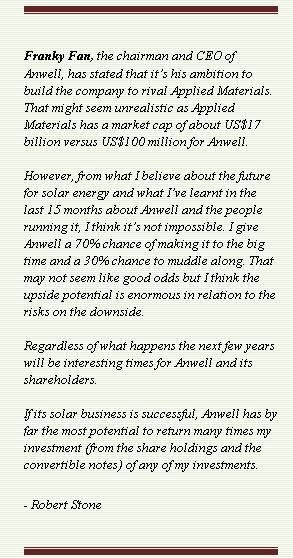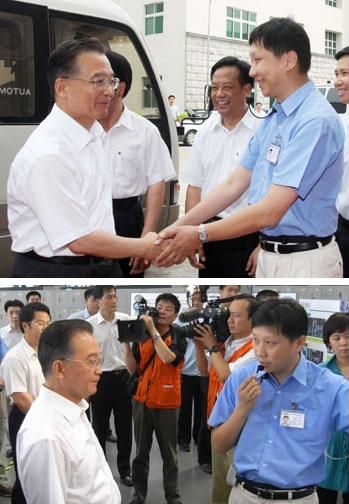Leong Chan Teik says > Robert Stone is not your conventional investor – he understands pretty well the industry dynamics of the companies he invests in and he is into them for the long haul, even if some of the stocks don’t do well for quite a while.
If that begins to sound like Warren Buffett, he has the results to vindicate his approach which has led him to become a millionaire many times over.
Just consider his $2 million investment in the convertible notes of Anwell Technologies last year. And his $1 million cash investment for a stake in a new subsidiary of Singapore Windsor a few months ago.
Anwell’s CFO Ken Wu was in town recently for a roadshow to highlight the solar business that the company is about to go full swing into. Around that time, in my regular email interaction with Robert, I caught a whiff of Robert's views of Anwell's solar business. That eventually escalated into a full-blown article, upon my request, here.

WHEN I INVESTED S$2m in the convertible notes of Anwell’s solar division just prior to the collapse of Lehman Brothers last year, I thought the biggest risk associated with the investment was whether or not the thin film solar line Anwell was building would actually work.
After the collapse of Lehman Brothers and the freezing of the credit markets, it seemed that not having sufficient cash to carry on with the solar project might be the greatest risk. However, with the government grants the company received as well as the cash flow from the optical disc business, cash has not been an issue for the company.
In the last 6 months or so, prices for both crystalline silicon and thin film solar modules have crashed due to a lack of financing for solar projects as well as overcapacity in the crystalline silicon sector.
On the positive side, Anwell has proven the ability of its equipment to manufacture thin film panels. On balance, I think the risk of the solar subsidiary being unsuccessful is less now that it was a year ago.
The recently-announced MOU with Solargen is potentially a huge source of income for the company. Assuming a range of US$0.20 to US$0.50/watt net profit, the total profit from this deal if it eventuates could range from US$250m to US$625m over a period of perhaps three years.
This is a huge amount but it’s not the potential profit that I think is significant. Instead, it’s the fact that an end user of thin film panels has chosen Anwell over Applied Materials. This despite Solargen stating on its website that it intends to use Applied Materials equipment.
Also significant is that Solargen has chosen Anwell’s amorphous silicon thin film technology over all the other types of technologies available. For solar generating plants, it ultimately boils down to which company and technology can provide panels at the lowest US$/watt.

The recent drop in thin film panel prices, while not necessarily favorable for Anwell’s panel manufacturing business, should benefit its equipment manufacturing business if lower prices spur greater demand for thin film panels.
I’ve always considered the solar equipment manufacturing segment the gem in the whole range of Anwell’s businesses. When it takes off, profit margins are likely to be high in comparison to any of the other business segments.In the longer term, the greatest potential for solar power generation is in China itself. Thomas Friedman recently described China’s decision to ‘go green’ as the 21st century equivalent of the Soviet Union’s sputnik launch.
There may be some hyperbole in that, but the seriousness of the Chinese leadership towards cleaning up the environment and reducing emissions from power generation should not be underestimated.
Although the government is not agreeing to mandatory caps on emissions under the Kyoto agreement, I believe that China will make larger and quicker cuts than any other major economy. This is not just about their determination to clean up the environment but is also due to the greater degree of control over the economy that they have relative to any other major country.
Specifically, the Chinese government has recently pledged to generate 15% of power from renewable sources by 2020. The target for solar power was raised from 1.8Gigawatts (GW) to 10GW by 2020. At the end of 2008, the installed solar capacity in China was in the order of only 100MW. The targeted installed capacity of solar is thus 100 times the existing capacity in 2008.
For wind power, the targets set by the Government just a few years ago have already been greatly exceeded. My bet is that the same success will occur with solar power generation in the next few years.
It will take some time for these plans to pan out. There are currently bottlenecks in the transmission infrastructure and a subsidy for solar power generating plants has only recently been decided upon as part of the ‘Golden Sun’ initiative.
In the last few months, several large solar farm agreements have been announced, the largest being 2GW in Inner Mongolia with First Solar providing the panels. These projects are likely to be just the first of many more which will be announced in the next few years.
Why is it reasonable to suppose that Anwell might benefit from this expansion in installed Chinese solar power generating capacity? If the solar power generating industry in China develops like the wind power industry there will be a favoring of domestic Chinese companies in the awarding of Government contracts.
Anwell may have an edge in winning contracts to supply panels and thin film manufacturing systems when bidding against foreign competitors. Anwell does not have any directly comparable domestic competition in the thin film sector so they will not just have the advantage of being the only Chinese company, they will also enjoy a much lower cost structure than their foreign competitors.

Negative operational earnings for 3-4 quarters?
Anyone investing in Anwell now should expect to be patient. In my opinion, it is likely to be well into financial year 2010 before any significant income accrues to the listed company from the solar subsidiary.
In the meantime, I doubt that the earnings from the optical disc businesses will be great enough to overcome the drag of depreciation charges on the bottom line. For the next 3 or 4 quarters, I will not be surprised if operational earnings remain negative.
What is important during this period is that the cash flow from the optical disc business remains good and the amount of cash the company has on its balance sheet is sufficient. On both these counts, I think there is no major cause for concern.
In the last few months of 2008 and the first half of 2009, I accumulated 4.5m shares. I’ve started buying again, having just recently overcome my normal disinclination to buy anything that has escalated three times in price in the span of a few months.
For more on the writer: ROBERT STONE reaping the rewards of 3 decades of investing
Read about Anwell CFO's recent meeting with analysts and fund managers: ANWELL on roadshow to highlight its solar story
